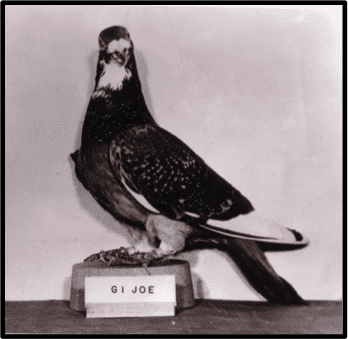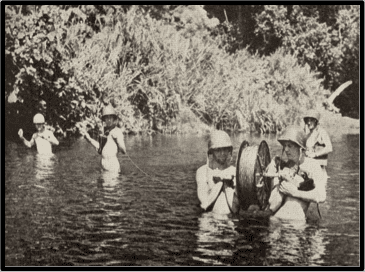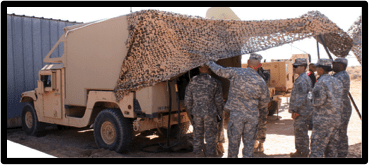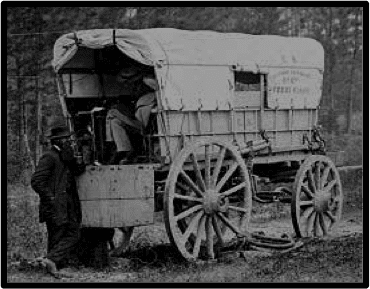Firing and Maneuvering
The $5B Global Tactical Advanced Communications Systems and Services (GTACS II) program has now joined the army of contracts that are in retreat. The RFP drop date for this program has moved to 2018.

Winging Their Way to Victory – Carrier Pigeon G.I. Joe, was awarded the Dickin Medal for gallantry, for “the most outstanding flight made by a U.S. Army homing pigeon in WW II.“ He is currently on display at the Churchill Loft, Ft. Monmouth, NJ, along with 24 other heroic pigeons.
No Place for Second Best
Winning a contract will be tough. Incumbents include top line military IT/Communications stalwarts such as CACI, D & S, DRS, GD, Harris, Lockheed Martin, etc.
Alongside the contract’s Full & Open/Unrestricted component, there’s an SBSA. Socio-economic considerations are big, with Small Business Participation Plans (SBPP) being factored into proposal evaluations.
Amateurs need not apply…. Because the challenges of solution design and drafting the GTACS II submission will be formidable.
Making the GTACS Vision a Reality
The challenges posed by today’s advanced tactical commo systems are not insurmountable. This is evidenced by performance on the current GTACS effort. Jim Sawall, a Government Product Manager said: “The current GTACS contract, which expires in October 2017, continues to deliver improved competition and reduced acquisition timelines that get programs on contract and capability into the hands of the soldiers more rapidly, and we are confident that under its new construct, GTACS II will be able to increase these benefits even more.”

Wired and Wet — Telephone linesmen ford Lunga River during the Guadalcanal Campaign of World War II.
The program is tasked with delivering one unified interoperable tactical network for soldiers on the battlefield to enable completion of successful missions.
The GTACS II follow-on is a 5-year, multiple award, IDIQ Firm Fixed Price, Cost Reimbursement, Cost Plus Fixed Fee deal covering a wide range of tactical C3T, hardware, software, engineering services, logistics support services, test- and system-related support.
GTACS II is intended to do the following:
- Provide for support in three functional areas — research and development, production and deployment, and sustainment and logistics;
- Support ground force tactical system requirements no matter where a program is in its lifecycle;
- Serve as a one-stop shop for a broad range of hardware and services; and
- Provide for an extended service range, enhanced flexibility and technical and operational consolidations enabling the Army, Department of Defense and other agencies to spend more efficiently and get needed capability into the hands of Soldiers in a compressed timeline.
This last point should be emphasized in proposal submissions.
Time is of the essence. One of GTACS II’s stated goals is to accelerate improvements to the tactical commo system. Those in the winner’s circle will have clearly demonstrated their ability to quickly respond to RFPs and TOs which could potentially be awarded in 120 days — versus nine months for the original GTACS contract – thus enabling the Army to get capabilities into the field at an accelerate pace.
Bidders take note! This compressed drawing board to frontlines timeline will be achieved through the following:
- Documentation standardization processes that can significantly decrease review cycles and
- A one-team approach to the entire contracting process.
(So addressing these issues is a must for proposal managers and writers.)
Bang for the Buck. As SATCOM Product Manager Sawall notes, “We’re looking for product innovation to provide the best capability possible for our Soldiers at a competitive price for our taxpayers.”

Plug and Play – Today’s advanced commo systems have to be ruggedized and made ready for tactical deployment.
The Army faces tight fiscal times as it modernizes its tactical communications capabilities. And bidders whose submissions satisfy program requirements with technologies and methodologies that save Uncle Sam a buck are far more likely to get the Army’s thumb’s up than their profligate competitors.
Cutting the Tactical Comm Mustard
Anyway, 30 prime contractors will make the cut. And the Army expects roughly a third to be awarded to small business, with a percentage set aside for women, veteran-owned, and disadvantaged or underutilized small businesses.
This competition is showing strong interest in the program. Expectations in the contract program office are high, and preparing proposals that win every possible evaluation point is a must.

Advanced for its Time — Telegraph Battery Wagon, Army of the Potomac HQ, Petersburg, VA, June 1864.
What the winners will need:
- To build a good team
- Strong response to sample tasks
- Price to win (PTW) study
- Risk management processes and procedures
- Ensure past performance write ups are properly prepared
So – bidders must demonstrate technical and managerial competence, of course — and the ability to deliver improvements to the Army’s tactical commo system expeditiously. And although this is not an LP/TA contract, a tight-fisted approach can help carry the day. That said….as Section M of draft RFP clearly states:
“Any awards to be made will be based on the best overall (i.e., best value) proposals that are determined to be the most beneficial to the Government, with appropriate consideration given to the four evaluation factors: Technical, Past Performance, Small Business Participation Plan (SBPP) and Price/Cost. The Technical Factor is more important than Past Performance. When combined, Technical and Past Performance are more important than Price/Cost. Offerors are cautioned that award may not necessarily be made to the lowest priced Offer.”




Leave A Comment